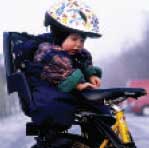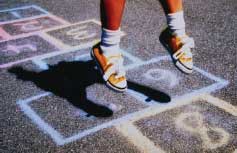|
| Front page | | Contents | | Previous | | Next |
Roads to Healthier Traffic
Children are particularly vulnerable
From studies we know that children are particularly vulnerable to the harmful effects of traffic. They may be more sensitive to noise – also traffic noise – than adults. If children are
exposed to traffic noise for prolonged periods, their reading ability, long-term memory and learning ability may be impaired. Children do not have the same possibility as adults to change
their physical surroundings. They depend on the good will of adults to secure good and healthy surroundings – also when it comes to noise.

Photo: BAM
Noise-sensitive children
The WHO points out that continuous traffic noise may impair the learning ability of children, especially in primary school. According to an EU report prepared by
the National Institute of Public Health in Denmark, even low noise levels may impair or delay the cognitive development of children. Noise may have a negative effect on language
perception – and, thus, the linguistic development, motivation and concentration – of children, and noise may also cause stress and impair sleep.
freedom to move around Several studies show that the mental and social development of children is furthered when children grow up in areas where traffic is limited. In residential areas
with low-speed regimes there are signs that the quality of life and the scope for development and interplay increase for all residents. Speed limits increase the safety of pedestrians and
cyclists, they benefit families with children, and offer more scope for children to move about, especially for children between the age of seven and nine.
Other studies show that when children cannot move around without being watched by adults, their social and motor development is impaired. They do not have the same freedom to
move around, and therefore do not get familiar with the local neighbourhood.
Good habits are formed at an early age
Recent years have seen a radical change in the habits of families with young children, for instance when it comes to transport to and from school. Increasing numbers of children are
taken to school by car, instead of walking or bicycling themselves. They might therefore get used to the car as the most important means of transport. It is important to make the way to
school safe, so that parents feel confident when teaching their children to go to school alone. Children who are not physically active are exposed to the same health risks as adults who
do not take enough exercise. One in five young Danes is not physically active and does not move around very much in his daily life. Adults are models to children – also when it comes
to physical activity.

Photo: Scanpix
Healthy cycling habits
The Danish Cyclists Federation has for many years been running the "Bike to Work" campaign, focusing on work- places. In 2002 a similar campaign,
"Freewheeling", was launched for the first time, directed towards schools and encouraging children to go by bike to and from school. Each class participates as a team, and prizes are
awarded to the winners. In 2003 more than 70,000 children took part in the campaign, corresponding to one tenth of all Danish school children from a total of 600 schools. The aim of
the campaign is to teach Danish children healthy exercise habits and to teach them to be physically active.
| Front page | | Contents | | Previous | | Next | | Top |
Version 1.0 June 2004, © Danish Environmental Protection Agency
|